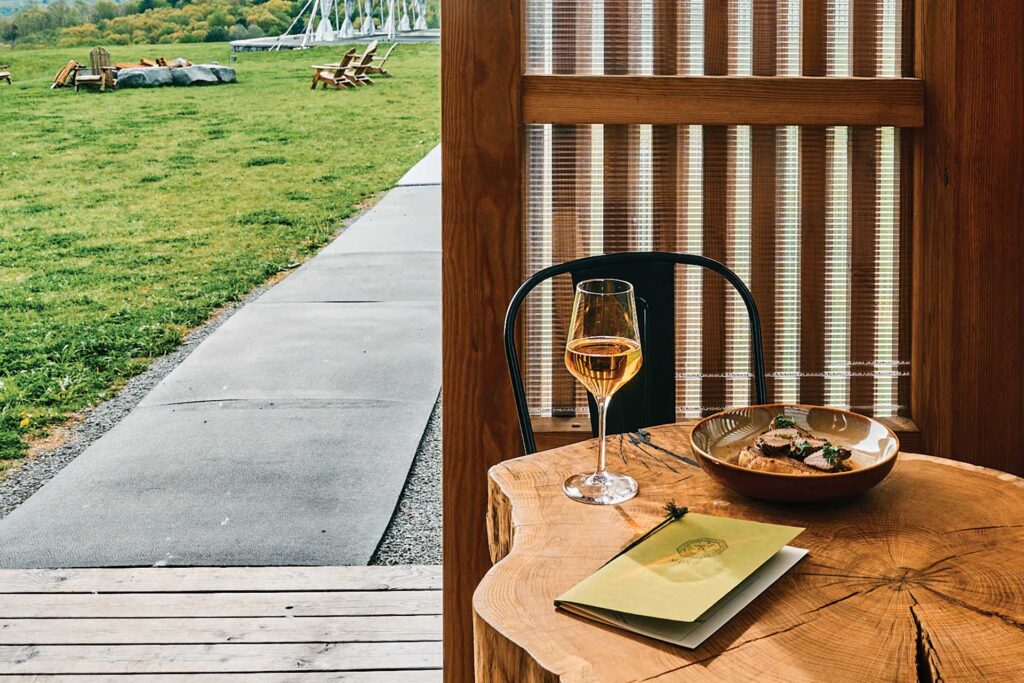Doug Doetsch returned to the Catskills to build an empire on Seminary Hill.
By Anthony Giglio
Photography by Daniel Schwartz
Among the first tasks European colonists in the Massachusetts Bay Colony set out to do—400 years ago—was to plant apple trees. Why? Because in Colonial America water was not safe to drink, so hard cider was the most common beverage, such that even children drank it in a diluted form.
Google the words “cider” and “founding fathers” and you might be surprised to discover that the great minds who dreamed up the architecture of our independent republic were fueled by gallons and gallons of cider (and Madeira and rum, too). But the late 1800s brought cider’s decline thanks to the rise of cities during the Industrial Revolution (unfiltered and unpasteurized cider didn’t travel well from farms to the emerging cities), as well as the ascension of beer—especially in cities filling up with German and Irish immigrants.
Doug Doetsch, co-founder of Seminary Hill Orchard & Cidery, happily recounts the history of cider in Sullivan County through the lens of his own personal history. “I’m originally from that little corner of the Catskills called Callicoon. My family on both sides have been in Callicoon for five generations, both were farm families, doing everything from dairy and vegetables to subsistence farming,” he recounts, adding, “New York is the richest agricultural market in the world!”
While Doetsch’s agricultural roots are (ahem) firmly planted in Sullivan County, his journey to apple husbandry took a detour when his dad got a job with General Motors and moved the family to the Midwest after Doug finished elementary school. After law school, he moved to New York City and started going to visit his grandparents a lot—his mom’s side was still up there. Around the same time, he met Susan Manning, now his wife and co-founder at Seminary Hill, and started taking her up to Callicoon to visit the family.
“She could see the authentic farm roots, and my thinking was that this might help my pursuit,” he says with a giant laugh. It worked. Well, at least the part about getting married. But instead of heading Upstate to start growing apples, they left for Chicago to start a family. “I’m a lawyer and Susan’s a professor, so we toggle between Evanston, IL and the Catskills,” spending at least a week a month there, he says. “We left New York City 35 years ago, but still go back regularly to see parents, grandparents, cousins, uncles, friends—we maintain firm roots.”
Sometime around 14 years ago, Doetsch started thinking of his second act, trying to bridge the connection between his family homestead and his agricultural heritage. He and Susan knew they wanted to make cider, but they quickly learned they didn’t know much about organic apple orchards and cider making.
That’s when he discovered Michael Phillips, who had written two books, The Organic Orchardist and The Holistic Orchard, both considered classic guides to both commercial and home growers. Phillips visited their land, took soil samples and told them the land needed some TLC by way of cover cropping to enrich the soil. They followed his advice for three years before planting their first 250 trees in 2014. Every year they’d get together with friends and family to plant another 100 or so trees.
Two years later, they turned their attention to another parcel they owned on a slope overlooking the Delaware. “From here there’s a view of a defunct seminary and the Delaware River snaking away at the bottom of the valley,” Doetsch reveals. Phillips said it’d be a phenomenal site for an orchard (with little need for cover cropping), so in 2016, they began planting 1,250 cider apple and cider pear trees on what would become their main estate. Sadly, Phillips passed away unexpectedly last year, but his legacy lives on. “Today we’ve got 1,500 trees,” Doetsch says.
With all the trees in place, all that was missing was a production facility with a tasting room. For this they enlisted James Hartford of River Architects in Cold Spring, NY. Hartford designed a “Passive House” structure that uses a voluntary standard for energy efficiency in a building, reducing a structure’s ecological footprint. He built their facility on the slope, deeply embedded in the hill, resulting in natural insulation on three sides, with the south facing side—the one with the seminary and river valley below—made mostly of glass.
“We get lots of light, and we set up with plenty of space for tanks, cold storage, pressing and lab work,” Doetsch says. Upstairs is a tasting room that turned into a full-service restaurant—“and it’s probably the best restaurant in Sullivan County,” he says smiling, crediting Chef Jack Tippett, who grew up on a farm in North Carolina hunting, fishing and foraging. “He does the same thing up here! The menu features lots of venison, duck, trout, hearkening back to 100 years ago in the Delaware Valley,” Doetsch explains, adding, “It might best be described as Country French or Tuscan, with lots of root veggies, but no tweezers.”
Back outside, they have 60 different varieties of apples and pears, used to make mostly dry ciders; some are sparkling, which Doetsch describes as essentially “pet nat,” which is the abbreviated nickname for pétillant-naturel, a French catch-all term for practically any low-sugar sparkling wine made in the méthode ancestrale, meaning the wine is bottled before primary fermentation is finished, without the addition of secondary yeasts or sugars. They also make a couple of semi-dry (slightly sweet) called Susan’s Semi-dry, and one with more sugar called Cackling Hen. By commercial standards they’re all on the dry side, in fact, some are quite tannic, all of them structured, and none of them contain any additives, such as spruce tips, honey or grapes—just 100 percent organic fruit. “The alchemy of cidermaking is taking the apples you’re given that year and turning out seven, eight or nine different ciders with differing flavor profiles,” says Doetch, “So, each year is a little different.” He should know.












Comments are closed.